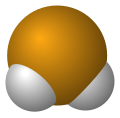Hydrogen selenide
Hydrogen selenide, also known as hydroselenic acid, selenium hydride, or selane, is a chemical compound. Its chemical formula is H2Se. It is an acid. It contains hydrogen and selenide ions.
| Hydrogen selenide | |
|---|---|
| IUPAC name | Hydrogen selenide |
| Other names | Hydroselenic acid selane selenium hydride |
| Identifiers | |
| CAS number | |
| PubChem | |
| KEGG | C01528 |
| ChEBI | CHEBI:16503 |
| RTECS number | X1050000 |
| SMILES | [SeH2] |
| Properties | |
| Molecular formula | H2Se |
| Molar mass | 80.98 g/mol |
| Appearance | Colorless gas |
| Odor | decayed horseradish[1] |
| Density | 3.553 g/dm3 |
| Melting point |
-65.73 °C, 207 K, -86 °F |
| Boiling point | |
| Solubility in water | 0.70 g/100 mL |
| Solubility | soluble in CS2, phosgene |
| Vapor pressure | 9.5 atm (21°C)[1] |
| Acidity (pKa) | 3.89 |
| Structure | |
| Molecular shape | Bent |
| Hazards | |
| EU classification | |
| Main hazards | Extremely toxic and flammable |
| NFPA 704 |
|
| R-phrases | R23/25, R33, R50/53 |
| S-phrases | (S1/2), S20/21, S28, S45, S60, S61 |
| Flash point | flammable gas |
| U.S. Permissible exposure limit (PEL) |
TWA 0.05 ppm (0.2 mg/m3)[1] |
| Related compounds | |
| Other anions | H2O H2S H2Te H2Po |
| Other cations | Na2Se Ag2Se |
| Except where noted otherwise, data are given for materials in their standard state (at 25 °C, 100 kPa) | |
Properties
Hydrogen selenide is a colorless gas that dissolves in water to make an acidic solution. It smells like rotten horseradish. It is very toxic. It burns easily, making selenium dioxide. It is similar to hydrogen sulfide, a gas that smells like rotten eggs. It is a strong reducing agent.
Preparation
Hydrogen selenide can be made by hydrolysis of aluminium selenide. This reaction also makes aluminium hydroxide. It can be made by reacting hydrogen with powdered selenium at a high temperature.
Uses
It can be used to add selenide ion to organic compounds. It can also be used to make selenium by reacting it with sulfur dioxide. This makes selenium, sulfur, and water.
Hydrogen Selenide Media
References
- ↑ 1.0 1.1 1.2 NIOSH Pocket Guide to Chemical Hazards. "#0336". National Institute for Occupational Safety and Health (NIOSH).


